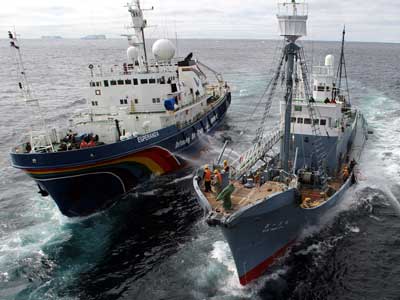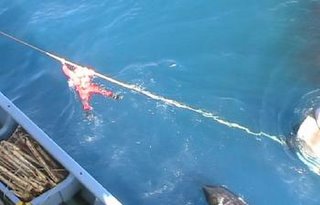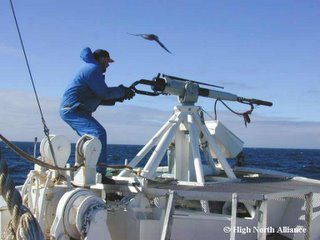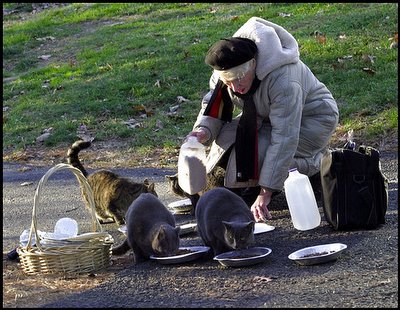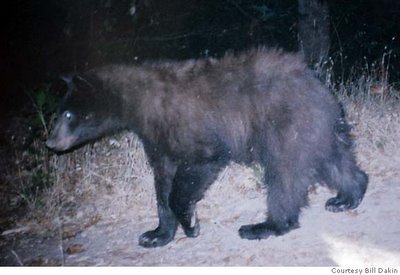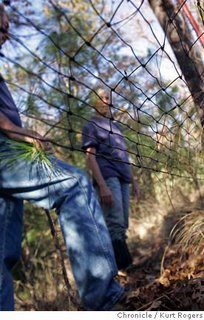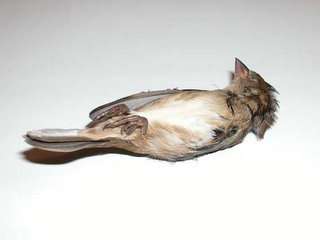Female Northern Bottlenosed Whale Dies in the Thames After a Botched Rescue Attempt

Londoners were treated last week to the rare sight of a whale in the Thames. Malheursement, the nineteen-foot female northern bottlenosed whale (Shown above swimming past the Houses of Parliament) was way off course and ailing after it had become separated from its pod. Rescuers sealed its fate by removing it from the water.
The whale, which is capable of diving up to three-thousand feet, was first sighted at around 8:30 a.m. on Friday, January 20th by a passenger on a train. A rescue effort led by the British Divers Marine Life Rescue (BDMLR) group was mounted early the following morning but the mammal died at 7 p.m. that evening just before bloodthirsty veterinary pathologist Dr. Paul Jepson of the Zoological Society of London (ZSL) was preparing to give it a jab of poison.
The rescue effort began near Battersea Bridge where rescuers steered the whale onto a pontoon (See photo below) in order to remove it from the shallow, brackish waters. It was then winched out of the water and placed on a barge belonging to the Port of London Authority; an inflatable raft was spread across the barge in order to lessen the damage to the multiple-ton whale's internal organs. (See photo at the bottom of the page.) Antibiotics were administered and the whale was wrapped in wet blankets and doused with water in an effort to keep it from dehydrating. Saturday evening it became disoriented and distressed and died, depriving its capturers of the pleasure of finishing it off.

The entire rescue effort was sheer barbarity and stupidity masquerading as compassion. First of all, the Thames should have been cleared of all water traffic in order not only to reduce the risk of collisions between the whale and boats but also so as not to add to the frightened animal's stress. Secondly, the whale should not have been taken out of the water under any circumstances. By removing it from the water the rescuers demonstrated that when it comes to whales they do not know their butts from a blowhole. The whale should have instead been towed to nearby marine mammal rehabilitation center where it could have been fed and medicated in a stress-free environment. For instance, the Marine Mammal Stranding Center in Brigantine, New Jersey is able to nurse back to health and release 88.9 per cent of the marine mammals that it rescues. If no such center was available, the whale should have been towed to open sea, given food and antibiotics, and released. Even if it did not recover, dying in the open sea would have been far preferable to dying in the clutches of its so-called rescuers.
Man, however, is such a low-down, rotten scoundrel that he cannot keep his filthy mitts off of anyone or anything. Despite the millions of years that he has tramped this planet, his tuition has never gone much beyond exploitation and extermination. Whales and other animals should be preserved in protected habitats; all tagging, vivisection, hunting, and confinement in zoos and circuses should be outlawed.
Confirmation that the rescue effort had been botched came quickly in the form of an eight-hour post-mortem conducted by scientists in Denton, Kent which concluded that the whale had died of hunger and dehydration. The whale did have a minor cut near one of her eyes as the result of a collision with a boat but she did not apparently have any internal injuries. Further tests will be conducted in the weeks ahead in order to check for bacterial infections and the presence of pollutants.

Sadly, it appears that the whale was worth more dead than alive to both the rescuers and scientists. She has already been carved up and her bones given to London's Natural History Museum for exhibition and research. In a January 23rd report, the BBC was conspicuously silent as to the disposition of the whale's oil and valuable ambergris but it did venture to hazard that its carcass would be incinerated if it is found to contain poisonous substances; otherwise, it will most likely be buried in a landfill. (See "What Will Happen to the Whale Now?") It strains credulity, however, to believe that the authorities are going to allow all that valuable blubber to go to waste.
The BDMLR group has also profited nicely from its ill-conceived rescue effort. For instance, while the effort itself cost the group a meager $9,000, it has since received more than twice that amount in contributions. Furthermore, it plans to auction off on the web a red watering can (See middle photo above) which it used to hydrate the whale. The capitalists and many animal rescue groups have more in common than is generally thought; not the least of which is a willingness to do almost anything for a few bob.
Although the unfortunate whale need not have died, the throngs of concerned Londoners who lined the banks of the Thames last week testified to the metamorphosis which has occurred over the years in English public opinion regarding whales. As Jonathan Leake pointed out in the January 22nd edition of The Times of London, the English were not always so favorably disposed to these behemoths of the deep. For instance, whales which wandered up the Thames in 1240 and 1658 were routinely harpooned without an iota or either appreciation or sympathy. Even as recent as 1961 a sixteen-foot minke was left to die in the Thames. (See "London's Whale History: We Weren't Always Quite So Sentimental.")
A spokeswoman for the Fund for Animal Welfare, which was also involved in the failed rescue, told London's Independent on January 24th that the emotional capital built up by the effort to save the northern bottlenosed whale should now be redirected toward saving whales elsewhere. "Tragically, it's too late for this whale, but another 1,000 whales are currently in the sights of Japanese whaling vessels. Whales around the world face deadly threats -- from whaling by Japan, Norway, and Iceland, pollution and habitat destruction, and increased noise in the ocean," she said. (See "Experts Examine Thames' Whale for Cause of Death.")
For additional information on the Japanese's whaling activities in the Southern Ocean Whale Sanctuary, see Cat Defender post of January 27th entitled "Sea Shepherd and Greenpeace Run Out of Fuel Leaving Minke Whales to the Mercy of Japanese Harpooners."
Photos: Port of London Authority (whale swimming and on pontoon) and BBC (whale on barge).
